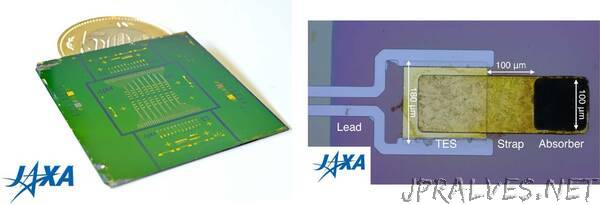
“There are countless stars in the current Universe, which are gathered together with the surrounding gas to form galaxies. More massive objects, such as galaxy groups and clusters of galaxies, then include dozens to thousands of galaxies. In this way, the Universe’s large-scale structure has been confirmed, in which smaller systems are densely packed together to form even larger structures. It is believed that the Universe’s large-scale structure has been gradually formed since the early Universe due to the gravitational instability of dark matter, and that the existence of dark matter is essential for explaining the current Universe. One of the most promising candidates for dark matter is an undiscovered elementary particle called an “axion.”
We have been particularly interested in improving the performance of the “superconducting transition-edge sensor X-ray microcalorimeter,” a next-generation sub-millimeter (a few hundred micrometers) size thermal detector for the ground-based detection of axions flying from the Sun. The heat generated in the detector’s absorber by incident particles is transferred through a gold thermal strap to a thermometer sensor made of a superconducting thin film. In this study, we deposited a highly thermally conductive strap that transfers heat without loss. This strap allows the heat to be propagated efficiently and is expected to provide higher spectral performance. In addition, we have succeeded in fabricating a 64-pixel array with iron absorbers and have made steady progress toward test observations.
Research Summary
An axion is a theoretical elementary particle whose existence has been predicted and is one of the leading candidates for dark matter. The Sun is one possible source of axion production. If axions exist, they are produced by the reaction of blackbody radiation photons1 from the solar interior with 57Fe2 in the central core. This reaction does not depend on whether axions are a significant dark matter component. We will clarify the existence of axions by using a superconducting transition-edge sensor X-ray microcalorimeter (hereafter referred to as a TES calorimeter3) to detect the 14.4-keV4 heat by the re-reaction of 57Fe on Earth. The advantage of this method is that it does not depend on the axion’s mass and does not require scanning the axion mass region since it only probes a fixed energy associated with the atomic transition.
TES calorimeters are highly sensitive to radiation in the X-ray band (several hundred eV to several tens of keV), including 14.4 keV, and demonstrate high spectral performance*5 when operated at cryogenic temperatures of around 100 mK with low thermal noise.
The TES calorimeter is a state-of-the-art thermal detector that will replace the semiconductor-based detectors that are currently the mainstream and will be installed on the large X-ray space observatory Athena in the 2030s, in which JAXA is participating as a next-generation spectroscopic instrument. In addition to spacecraft applications, various uses have been proposed, including medical applications for gamma-ray detection, analysis of extraterrestrial materials, including samples from Hayabusa2, and ground-based Axion exploration, which is the subject of this paper. The size of each TES calorimeter is about a sub-millimeter (a few hundred micrometers). However, for efficient axion observation, the mass of 57Fe that reacts can be increased while expanding the sensitive area by arranging many TES calorimeters in an array. It is expected to achieve unprecedented detection sensitivity after 100 days of observation using a 10,000-pixel array (Yagi et al. 2023a, J. Low Temp. Phys.).
The energy of each particle can be detected by transferring the heat generated by the absorption of the particle to the TES and measuring the temperature rise. The TES, the thermometer sensor to detect heat, is made of a superconducting thin film. The TES and the iron absorber are placed horizontally apart so that the magnetism of the iron absorber does not degrade the spectral performance. The heat generated in the iron absorber is transmitted to the TES through a gold thermal strap (Fig. 1). The principle of detecting heat is expected to dramatically improve the detection efficiency*6 compared to currently mainstream detectors that detect electrical signals such as electric charges (e.g., silicon-PIN detectors).
The thermal strap must have high thermal conductivity to propagate the generated heat without loss. We therefore searched for appropriate conditions by changing the deposition conditions using the electroplating method7, which has been reported to be capable of depositing films with high thermal conductivity. As a result, we succeeded in depositing a film with thermal conductivity more than eight times higher than that of gold straps deposited by the conventional vacuum evaporation method8. Similarly, because high thermal conductivity is required for iron absorbers, films were deposited by the electroplating method. However, there were few previous studies on the deposition of pure iron, not an alloy, so we used 56Fe, which is ordinary iron, to identify appropriate conditions. In this fabrication, we deposited an iron absorber with sufficient film thickness and, for the first time, formed the structure of a 64-pixel TES calorimeter array with iron absorbers (Fig. 2). In the future, evaluating the spectral performance of elements fabricated under these deposition conditions will be necessary.”
